Glimpses of Healing and Hope
Glimpses of Healing and Hope

March 13, 2017
By: Jane Bishop Halteman
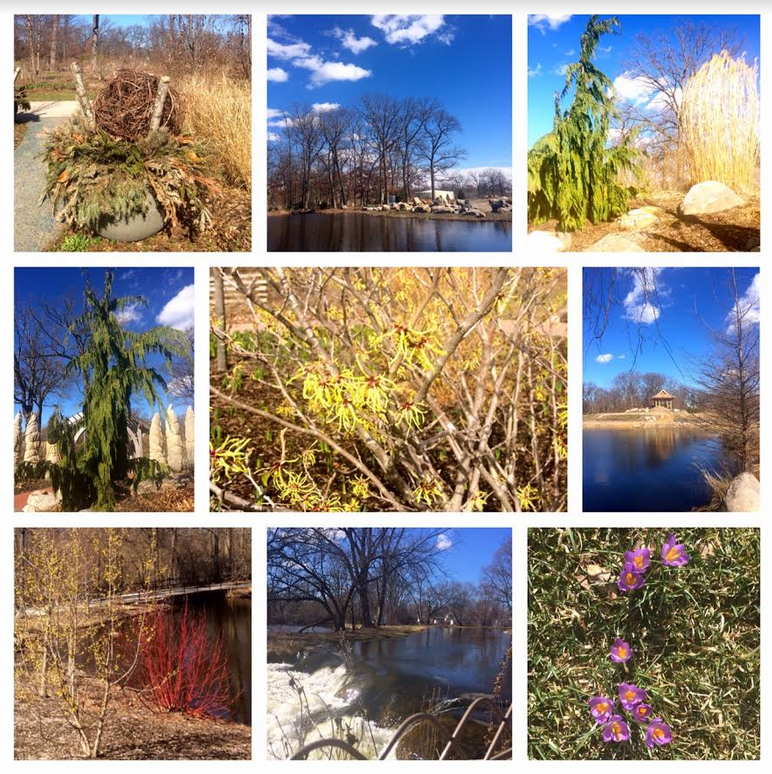
'There is no end to things that can awaken our wonder'
(Wellfield Botanic Gardens showing signs of spring last week)
As people of faith, we trust that the Divine, the great Mystery, is present with us in our wondering. In response to an invitation from worship planners that I share on wonder during the Lent 2 service Sunday, I did a lot of wondering last week about whether I should address wonder the noun, as in awe and wonder, or wonder the verb as in “I wonder why that happened to me, to us, to our country, to the world.” I came up with this amalgam of the ways wonder has impacted me over the years.
When I was very young, my wondering and sometimes wandering mind, of its own volition, it seemed, tended toward negative wonderings based on some of the things I was taught as a child…I was preoccupied with questions like “would I be good enough to go to heaven,” “would the second coming take place before I was old enough to get married or have children,” “would someone close to me die prematurely?” None of these wonderings brought me to a place of happiness, and I became an anxious child. Eventually I wondered how I would continue to navigate my life when my boyfriend died in a truck accident after my sophomore year of high school and again after my 18-year-old brother died in a car crash when I was 28.
The births of our two children in the 1970s brought good wonder, as in awe, to my life and, in the mid-90s, when I first began to receive spiritual direction, I became acquainted with authors who taught me more about the positive side of wonder. Flora Slossen Wuellner’s writing revealed that tended wounds can become sources of new life and the channel of healing for others: that fear when healed becomes compassion, that destructive anger becomes a passion for justice and righteousness, that perfectionism becomes joyous power to build and create.
Other amazing writers, like Jan Richardson, offered wondrous new learnings including the observation that each “moment holds the possibility of encountering the sacred. Waking, eating, reading the paper, working, playing, talking, doing laundry, doing dishes, doing errands, doing nothing”…all of these interactions invite us to wonder how God is with us and who God becomes for us.
In my older age, positive wonder comes much more easily with four grandchildren now on the scene who open the door to delight in many age-appropriate ways as they learn and grow. Nature has taken on a robust capacity to offer seasonal awe and wonder. My love of writing and photography continues to accelerate in these retirement years. I am awed by the privilege of journeying with directees and sharing community with family and friends.
As G.K. Chesterton suggests, “At the back of our brains, so to speak, there (is) a forgotten blaze or burst of astonishment at our own existence. The object of the artistic and spirited life (is) to dig for this submerged sunrise of wonder.”
For more on wonder as a spiritual practice, I searched the Spirituality & Practice website, where authors Frederic and Mary Ann Brussat note that “wonder begins in the senses, comes alive in the imagination, and flourishes in adoration of the Divine….There is no end to the things that can awaken our wonder, from the majesty of the night sky to the smell of lilacs in the spring to the turning of the leaves in the fall. And it is all right here, a feast of epiphanies and astonishments in the daily round of our spiritual lives.”
In its review of The Zen of Seeing (Seeing/Drawing a Meditation) by Frederick Franck, the website points out that “where there is revelation, explanation becomes superfluous. Curiosity is dissolved into wonder.”
The site also offers this Mark Nepo book excerpt from The One Life We’re Given on the practice of cultivating wonder and this link to an excerpt from Robert C. Fuller’s Wonder from Emotion to Spirituality. Nepo suggests that “our challenge is not to choose between the fragility and strength of life but to cultivate our wonder by holding both in our heart. Life is fragile and unbreakable. We teeter and we soar; often at the same time. Wonder helps us find the indestructible part of the thread.”
Fuller says this: “We can efficiently go through life without delighting in experiences of wonder. Many people do. But it must also be emphasized that no other emotion so effectively induces us to pause, admire, and open our hearts and minds. No other emotion so readily kindles a reverence for life.”
How might you further develop the practice of wonder as a spiritual discipline this Lenten season? Consider your past experiences of wonder and how they have changed you. Determine the places in your life most likely to arouse wonder and resolve to spend time in those places this Lenten season.
Add a commentMarch 6, 2017
By: Jane Bishop Halteman

Vincent van Gogh's At Eternity's Gate, 1890, oil on canvas
“During Lent,” says Christine Valters Paintner in a Patheos piece published in 2011, “my practice will be truth-telling. I will inhabit my places of grief, the sorrows I have resisted up until now, and allow my unspoken lament to rise up in me like fire. I will turn off the endless noise and chatter that distract me from those places where my heart has hardened. I will be in solidarity with those who have no voice and listen for their silent groans. I will trust along with our spiritual ancestors who wrote and sang the Psalms in the assembly, that when I go to the rawest, most vulnerable places, my soul is then transformed....”
According to Valters Paintner, “Each one of us carries grief, sorrow that perhaps has gone unexpressed or been stifled or numbed. Each of us has been touched by pain and suffering at some time. Yet we live in a culture that tells us to move on, to get over it, or to shop or drink our way through sorrow.”
Listening to the fourth movement of Tchaikovsky’s Symphony No. 6 in B minor Tuesday night at a Goshen College Performing Arts Series concert featuring the National Symphony Orchestra of Ukraine, I found myself lost in an intense crush of palatable pain and grief.
I knew little to nothing about this work and and its fourth movement prior to hearing it last week; when I googled it for more information, I was aware only that no music had ever moved me to such deep sadness in the way this piece did, so I was not surprised to discover that one listener called it “tragically and achingly beautiful.”
Perhaps the ability to recognize that beautiful but tragic ache requires that one has experienced some aspect of grief in life, as, of course, most of us have. In my case, I learned to manage, even stifle, a largely hidden sadness for many years, one brought on by the death of my boyfriend the summer after my sophomore year of high school and further compounded 12 years later by the death of my 18-year-old brother.
In the same way that the Tchaikovsky movement demands that we pay attention to our own griefs and losses, Vincent van Gogh’s At Eternity’s Gate allows us to surface private pain. Contrary to what we have sometimes been taught about van Gogh, Kathleen Powers Erickson writes in her book At Eternity’s Gate that “belief in a ‘life beyond the grave’ is central to one of van Gogh’s first accomplished lithographs, At Eternity’s Gate. Executed at The Hague in 1882, it depicts an old man seated by a fire, his head buried in his hands. Near the end of his life van Gogh recreated this image in oil (see above), while recuperating in the asylum at St. Rémy. Bent over with his fists clenched against a face hidden in utter frustration, the subject appears engulfed in grief. Certainly, the work would convey an image of total despair had it not been for the English title van Gogh gave it, At Eternity’s Gate. It demonstrates that even in his deepest moments of sorrow and pain, van Gogh clung to a faith in God and eternity, which he tried to express in his work.”
Erickson goes on to say that van Gogh’s Starry Night (see below), painted in 1889, “is a visionary masterpiece, recounting the story of van Gogh’s ultimate triumph over suffering, and exalting his desire for a mystical union with the Divine,” as suggested by “the cypress, which shoots up into the firmament like a giant flame.” The painting, she says, “reveals that he did not close the door on religious faith,” rather on organized religion as illustrated by the darkened church building. The work also depicts “the triumph of the mystic’s communion with God through nature.”
Valters Paintner suggests these practices to help create what she calls intentional space for grief: Make room for others to share their sorrows. Ask friends about their recent losses and listen well to their stories. Consider the ways you may unknowingly perpetuate the world’s pain. Speak your lament in public, perhaps via opinion pages. Write your own prayer of lament inspired by the Psalms. Practice truth-telling by refusing to say that all is well if it is not.
Whether our sorrow is personal or grows from the aches and pains so present in our own country and the world today, may we find ways to care for our private grief this Lenten season so that we might listen for the silent groans of those who have no voice.
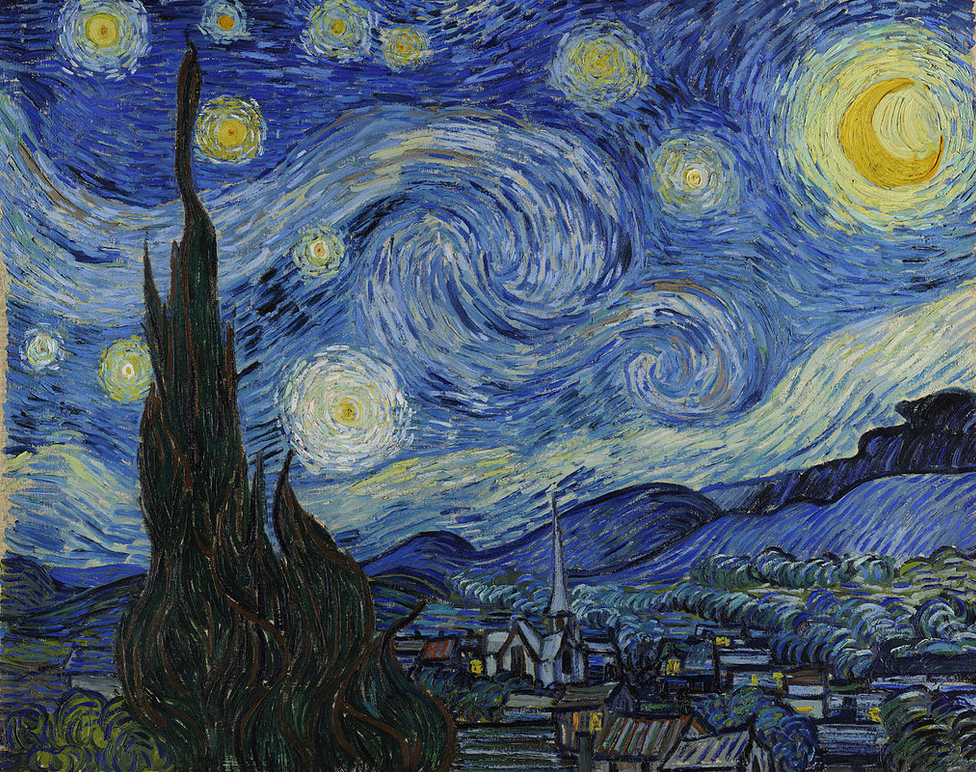
Vincent van Gogh's Starry Night, 1889, oil on canvas
Add a commentFebruary 27, 2017
By: Jane Bishop Halteman
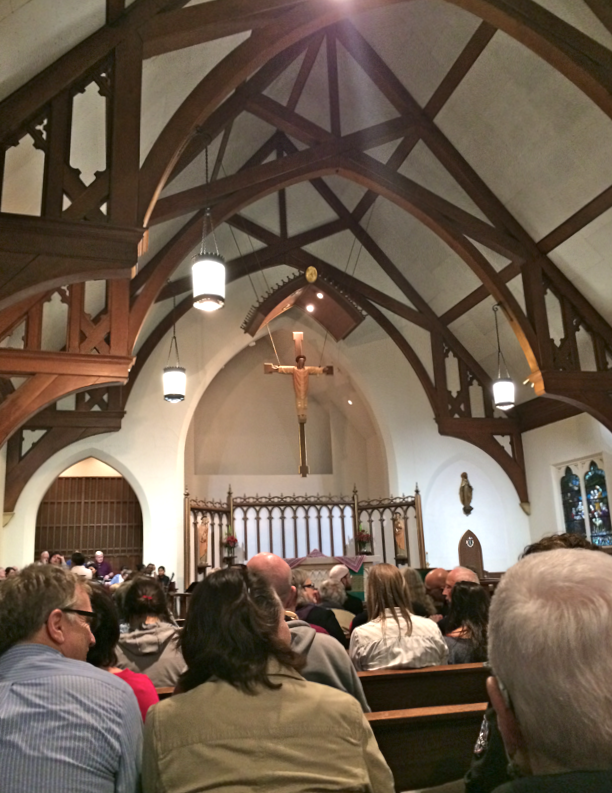
Interfaith prayer service for compassion and justice for migrants, immigrants, and refugees
Every year about this time, we encounter the “what are you doing for Lent?” question. As a long-time advocate of “adding in” opportunity to create more space for God in our lives as opposed to “giving up” during Lent, I liked what I read last week in this blogpost by a spiritual director friend of mine.
June’s post explains that “the word ‘Lent’ comes from Old English, meaning ‘spring’ or ‘lengthen’ as in the lengthening of the days. This is not the image of a spring of pleasant warmth but an image of change—of transformation, of conversion. In the lengthening brightness from Ash Wednesday to Holy Thursday—our Lenten spring—we are called to offer our brokenness to God. In offering our own brokenness we can then offer the world’s brokenness to God.”
Several other readings caught my attention as well. This one speaks of 19 things to give up for Lent that aren’t chocolate. The list includes fear, the need to please, envy, impatience, a sense of entitlement. I expect giving up the tendency toward any of these habits would help create space for the Divine to carry on with the work of personal transformation.
Back in 2015 Pope Francis suggested that “even more than candy or alcohol, we (might) fast from indifference towards others” as he spoke of the approaching season of Lent and what people might consider giving up: “Describing this phenomenon he calls the globalization of indifference, Francis writes that ‘whenever our interior life becomes caught up in its own interests and concerns, there is no longer room for others, no place for the poor. God’s voice is no longer heard, the quiet joy of his love is no longer felt, and the desire to do good fades.’ He continues that, ‘We end up being incapable of feeling compassion at the outcry of the poor, weeping for other people’s pain, and feeling a need to help them, as though all this were someone else’s responsibility and not our own.’”
I often look to Parker Palmer for wisdom; he rarely disappoints. This past week, just in time for us to put into practice our Lenten disciplines, he offered a Naomi Shihab Nye poem entitled Shoulders to urge all of us toward helping the marginalized: “Whatever one’s politics may be, people of good will must not forget that many of our fellow citizens and their children are feeling increasingly vulnerable, insecure, and threatened.”
Speaking of Hispanic and Muslim children, African American children, and Jewish children who have been made fearful in recent weeks for one reason or another, Palmer urges us “for at least a moment, not to turn this into a debate between those who voted for X and those who voted for Y. Too often, that kind of talk gives us a cheap excuse for ignoring the suffering of our brothers and sisters and their children….Let’s do whatever we can to befriend and defend the victims of ignorance, hatred, and anger.”
Actions to befriend and defend took center stage in South Bend this past week as approximately 300 persons gathered Monday night at The Episcopal Cathedral of St. James for an interfaith prayer service for compassion and justice for migrants, immigrants, and refugees. As he welcomed the crowd, our mayor spoke of the example of “unity through diversity” that participants represented. “All of us need to have a sense of home,” he said. “My hope is that greater South Bend will continue to call out hope for all.” Another of my favorite take-aways from this invigorating evening together: “Teach us to rejoice in the diversity; transform us all into your holy body. Teach us to give thanks for what we have by sharing it with those in need.”
Kern Road took befriending and defending to another level Sunday (February 26) as our Global Partnership and Immigration Committees hosted a fundraiser potluck to help those among us attempting to bring family members to safety, whether they be orphaned grandnephews from Kenya or our Mexican friend’s daughter, who is seeking asylum in our country. See details on the Kenyan story in this 2016 Glimpses of Healing and Hope post.
Here’s an abbreviated version of what KRMCer Sarah said in a Facebook post about the fundraiser: “Today, as I stood and counted the people at church (in my usher capacity), it made me smile to see the diversity. We have been speaking about Holy Spirit the last several weeks, and I have pondered how welcoming the people of Kern Road are. Our God works in mysterious ways and has led people to Kern Road who had never even heard about Mennonites. I watched the joy on our new friends’ faces as we introduced ourselves. I am proud that our church family is standing by the values of our mission statement and walking alongside the refugees and immigrants of this time.”
For more on Lent and Ash Wednesday, follow this link to last year’s Glimpses of Healing and Hope reflections on Peter Bruegel the Elder’s painting of The Fight Between Carnival and Lent. If you are looking to involve yourself in a Lenten study, consider these Spirituality & Practice e-courses on The Transformation of Suffering: A Lenten Journey or Becoming Truly Human. Kern Road's Ash Wednesday service will begin at 7 p.m. in the chapel.
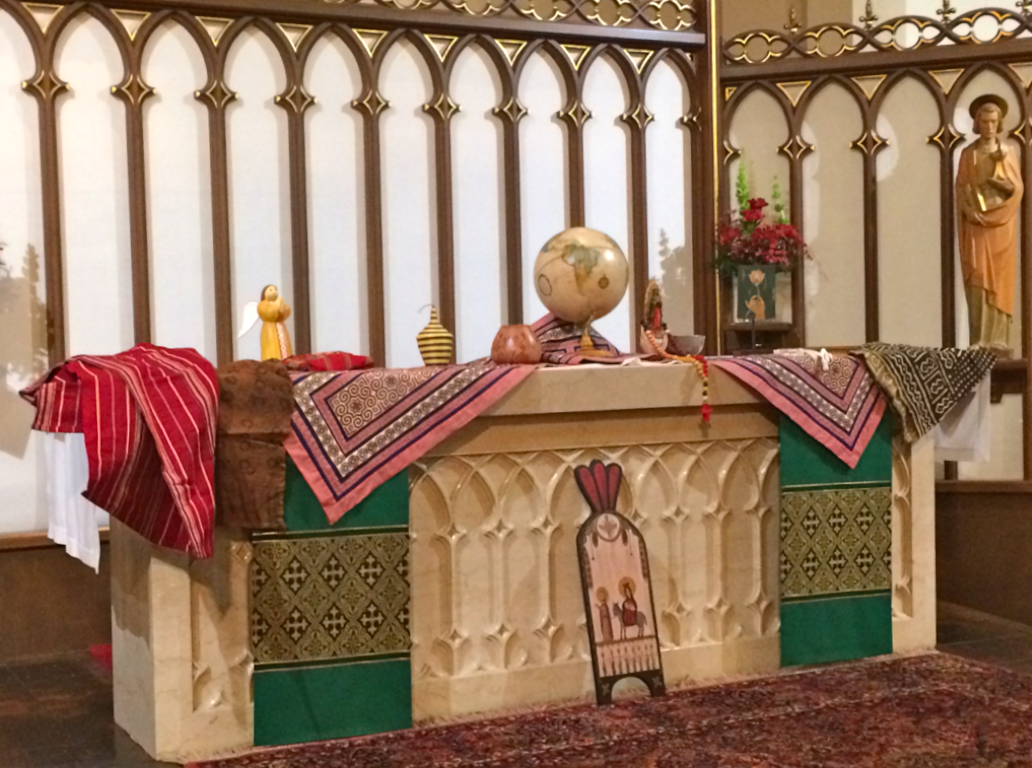
Artifacts representing participants' unity through diversity at The Episcopal Cathedral of St. James
Add a commentFebruary 20, 2017
By: Jane Bishop Halteman

Restoration Farm hosts potluck/hymn sing…“like a tender breath stirring”
KRMCers indulged in fun Saturday night at John and Danile’s Restoration Farm hymn sing, where those gathered sang together, ate together, conversed together, played together. In the midst of the singing, they took turns filling their plates with stew, fruit and vegetable salads, pasta, chocolate covered strawberries, puddings, and pies while children played outdoors near the bonfire and grazing livestock in the unusually warm February weather.
An eight-year-old who opted to be outside during much of the sing had fun chasing “trolls” around the fire and learning from host John about the evening star Venus which showed up brilliantly, along with the constellation Orion, in the dark sky away from city lights. His older sister discovered (and named) various cats roaming the property.
“This will be the third year for the hymn sing,” Danile said in advance of the event. “I originally did it for my 60th birthday celebration, and we had organized chaos with 60-some people. I have a friend who does this every year and that’s how I got the idea. Though there is food out to eat and people do other things, bonfire, conversation, I am pretty serious about singing, so we concentrate on that. It is a good time that people comment on enjoying. We are not tying it to my birthday anymore and it fits in with the vision of Restoration Farm to facilitate community, work, prayer, and fun.”
Those of us who showed up this weekend were invited to choose songs from three congregational hymnbooks. Our selections offered insights into why we might have decided to participate: I bind my heart this tide (#411 in Hymnal A Worship Book), God of many names (#77 in Hymnal A Worship Book), On Jordan’s stormy banks I stand (#610 in Hymnal A Worship Book), Like a tender breath, stirring (#106 in Sing the Story).
Because it was suppertime, we also sang several evening songs…something we don’t get to do a lot in our regular worship services, one participant said. He selected number #551 in Hymnal A Worship Book…In the stillness of the evening, perhaps more honest, he suggested, about the nature of some of our days as it references “defeats looming large” and “pieces lying broken.”
As many seek out refueling and refreshment stations in these strenuous days, I’m paying attention to the choices they are making to further ground themselves. Several KRMC families are moving to be closer to already established communities within the congregation. (See Nancy’s story here.) Others are availing themselves of communal educational opportunities at establishments like the Local Cup in the Near Northwest Neighborhood. Some chose to be on hand for the recent public opening of the new chapel at The Catholic Worker's Our Lady of the Road day shelter.
A number of persons indicated during worship yesterday that they will be attending an interfaith service of prayer tonight (Monday) for compassion and justice for migrants, immigrants, and refugees. Hosted by St. James Episcopal Cathedral, the event is sponsored by 28 churches and faith-based organizations including KRMC.
Hopeful green shoots already are sprouting in the congregation in response to local and worldwide needs: the new Beginning English formation hour class which launched yesterday for non-English speakers under Cal's leadership, the above-budget potluck fundraiser slated for Sunday, February 26, by our Immigration and Global Partnership Committees, and the ongoing collection for refugee relief kits to be distributed by Mennonite Central Committee. Relief kit materials can be delivered to Kern Road Mennonite Church Tuesday through Friday during office hours or to Ten Thousand Villages in Mishawaka during store hours.
Some of us, like myself, made attending Restoration Farm’s hymn sing/potluck a priority for the communal connection. I particularly enjoyed the sustaining refrains of Like a tender breath, stirring: “Like a tender breath, stirring, your word breathing in us, like a potter’s clay vessel, your love making and shaping.” Singing it with two rooms full of people definitely maximized the refueling and helped to fortify hope.
Jan Richardson’s words about hope (from her 2017 Women's Christmas Retreat) sustain me as well. “Hope starts small, even as a seed in the womb, but it feeds on outrageous possibilities. It beckons us to step out with the belief that the action we take will not only bear fruit but that in taking it, we have already made a difference in the world. God invites us to open to God’s radical leading, to step out with sometimes inexplicable faith, trusting that we will find sustenance.”
“Where does your hope begin?” Richardson asks. “Where does hope live in you…how do you notice it in your body? When has someone shown up in a way that enabled you to hope in something that seemed impossible?”
Richardson offers this blessing for hope:
“Guardian of the seasons,
keeper of every time,
tune us so to your rhythms
that we may know
the occasion for stillness
and the moment for action.
May we be so prepared
so aware
so awakened
in our waiting
that when you prompt us
into motion,
our hands may be your hands
and our purposes
your own.”
May her blessing continue to come to life in us as we restore ourselves for the sake of the other.
Add a comment
February 13, 2017
By: Jane Bishop Halteman
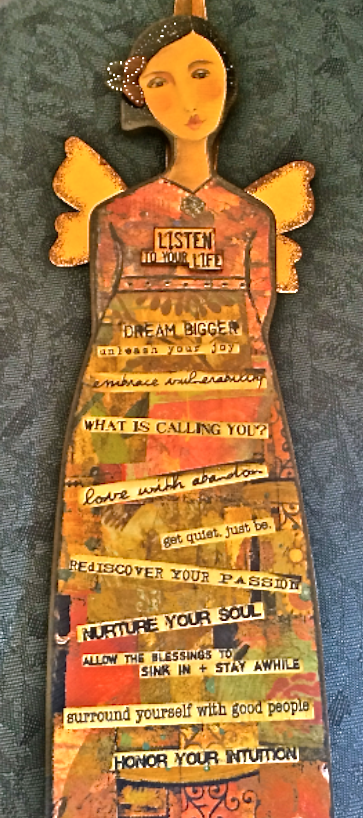
Last week, as I prepared the room for our Visio Divina adult formation class, I spotted the angel image pictured above hanging on a central pillar in our space. Though I had noticed her there before, I have no knowledge of her origin and had never stopped long enough to read the wisdom bites sprawled across her being: “Listen to your life, dream bigger, unleash your joy, embrace vulnerability, love with abandon, get quiet/just be, rediscover your passion, nurture your soul, allow the blessings to sink in and stay awhile, surround yourself with good people, what is calling you?”
Whether she was handmade or store-bought, I do not know, but sitting with her for a while to ponder her wise suggestions seems like it could be a promising exercise. She remained in our midst yesterday as participants considered their Divine invitations while we prayed with Fra Angelico’s fresco of the annunciation at the Convent of San Marco in Florence, Italy.
Even as several in the class are presently involved in packing up their belongings to move closer to others in the KRMC community, the current plight of our country’s immigrants, and their fear of being dislocated against their will, is not far from our minds. Perhaps we have read Mennonite Central Committee’s (MCC) recent statement on immigration and refugees or are involved in South Bend with folks who have reason to fear the kind of raids my Facebook friend Mike speaks of having witnessed this past weekend in Austin: “Over the past few days in Austin there have been ICE raids all over town, some in neighborhoods where friends of mine live. Helicopters have been circling overhead all night, keeping people awake. Federal agents are dragging people out of their homes, away from their children. They are getting violent with people. They are setting up traffic checkpoints and pulling over random brown people. Children are being sent home from school with notes in their backpacks with instructions on what to do if the government has taken away their parents while they were gone. School kids are frightened for their families, for their friends, for themselves. People are terrified and feeling helpless. Because. Of. Our. Government.”
Sue, another Facebook friend and former KRMCer who recently moved to Atlanta, posted this as introduction to a poem entitled Home by Kenyan-born Somali poet Warsan Shire: “The powerful poem here expresses the stories of refugees I met in Kosovo, Kansas City, Minneapolis, South Bend, and now the greater Atlanta area. What circumstances could you possibly imagine would propel you to leave your homeland?”
As we mull over ways we at Kern Road might make ourselves and our resources available to those who need our assistance, may we recall these words from the poem: “You only leave home when home won’t let you stay.” Our congregation’s Immigration and Global Partnership committees are looking to establish a substantial, above-budget immigrant and refugee fund, which they will get off the ground with a potluck fundraiser Sunday, February 26. These committees invite us to come with a “generous spirit and ethnic dishes” to share.
How do we best prepare ourselves for the new challenges ahead? A Sojourners article by Lindsey Paris-Lopez says that “the Sermon on the Mount catches us in the current of our cultural violence and turns us around first by drawing our attention to the victims swept under the wave of human violence.” She indicates that “now is the time for a robust theology of resistance” and offers this question for consideration: “How are the poor in spirit, the mourners, the meek, the ones who hunger and thirst for justice, blessed? Jesus blessed the people on the margins of his culture by embracing them, showing solidarity with them, building a community in which those who had always been shunned were welcomed and loved. As the body of Christ, we are called to be that blessing.”
As we prepare for the work of welcoming the other (or another task toward which we may be feeling nudged), I trust we will take to heart Pastor Janice's reminder that “the Spirit gives us a kind of resilience” for what lies before us. Find details here about a South Bend informational meeting regarding immigration rights and concerns from 5-7 p.m. Friday, February 17, at Harrison Primary Center.
When we need breaks from writing and calling and resisting and marching and monitoring and fund raising, we might take delight in positive, simple, soul-nourishing narratives like these: this forgiveness story which appeared on the CBS Evening News, this One Green Planet piece about a rescued cow basking in the sun with a human friend, and this example of a delightful new quilting apparatus created by a personal friend’s mother and brother.
And we might all benefit from taking the time to consider our angel advisor's recommendations at the start of this post: “Listen to your life, dream bigger, unleash your joy, embrace vulnerability, love with abandon, get quiet/just be, rediscover your passion, nurture your soul, allow the blessings to sink in and stay awhile, surround yourself with good people, what is calling you?”
One of the mini ways I nurture my soul each day is by snapping a photo to live into the mindfulness prompt #100happydays. These are the first nine photos I created of people, places, experiences that took me to a happy, grateful place in February. How do you nurture your soul when you are called to love with more abandon than ever?
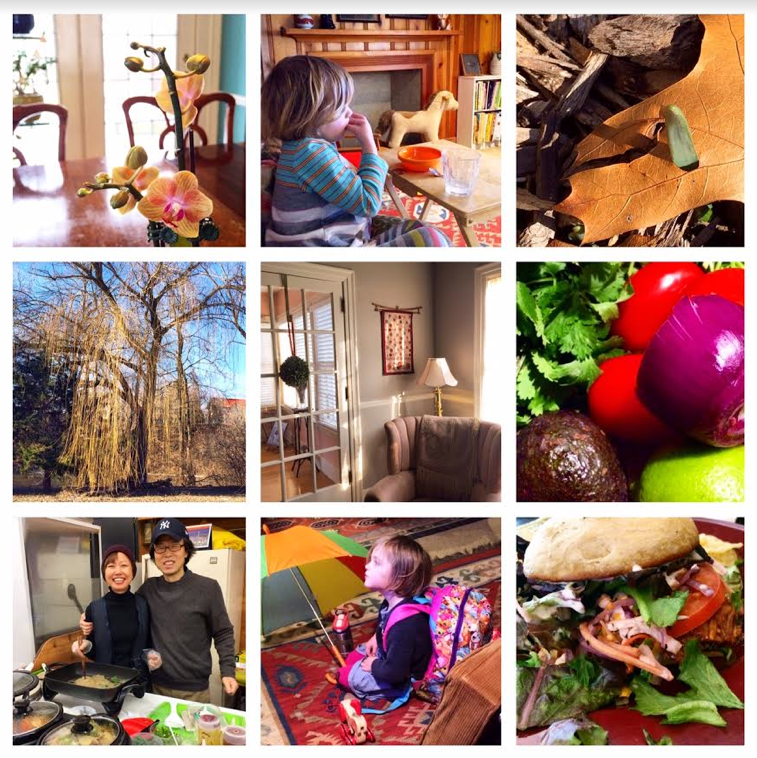
The first nine days of my #100happydays photos:
categories are not surprising (family, food, nature, with hygge binding them together at the center)
Add a commentFebruary 6, 2017
By: Jane Bishop Halteman
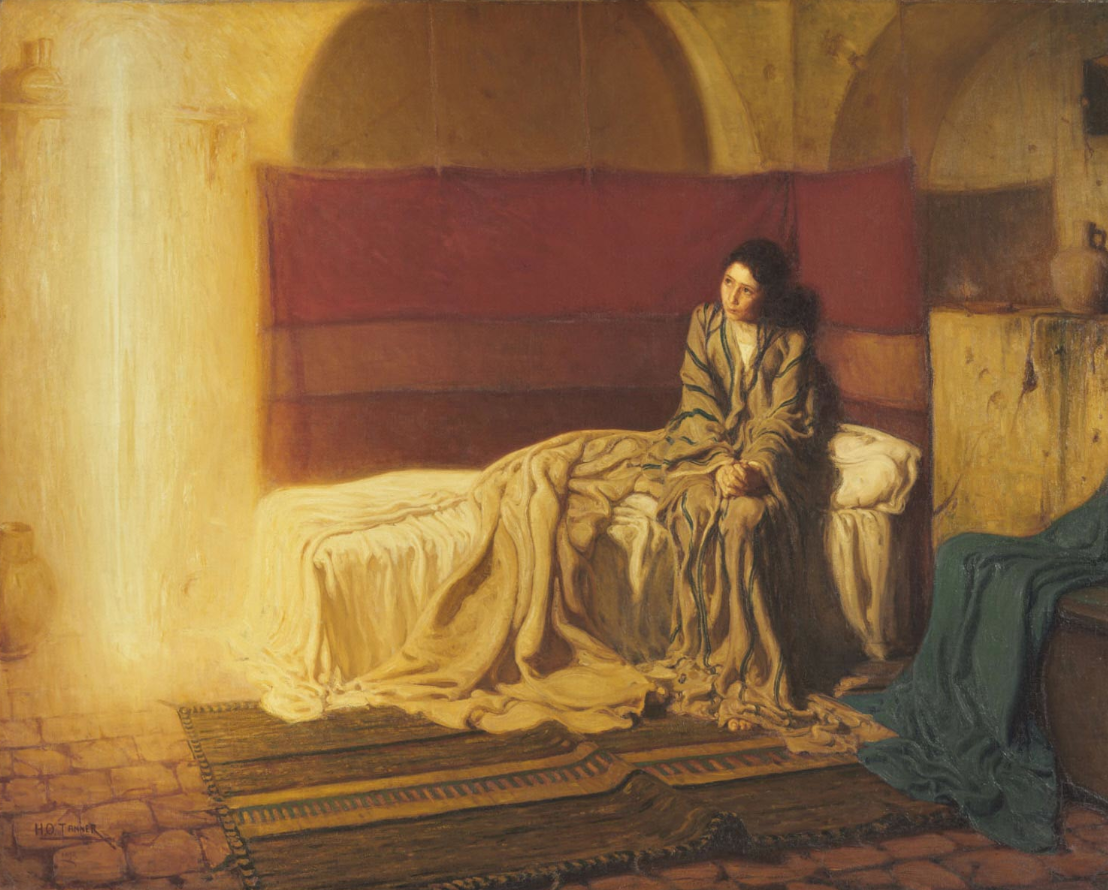
The Annunciation, oil on canvas by Henry Ossawa Tanner in 1898, from the collection of the Philadelphia Museum of Art
The adult formation class Sherry and I presently are co-leading describes itself this way: Visio Divina (divine seeing) involves praying with art. Scripture illustrates that images are an important part of how God communicates. As we sit in quiet contemplation with images from artwork, we trust we will be invited “to see deeply, beyond first and second impressions, below initial ideas, judgements, or understandings. Visio Divina invites us to be seen, addressed, surprised, and transformed by God who is never limited or tied to any image, but speaks through them.” Come each week from wherever you find yourself, in your joy and contentment, your anxiety and uncertainty, your grief and sorrow, as we seek together to see God's work in the world and our lives at a contemplative pace.
We will be using images of Mary, some of the time…maybe all of the time, for these 11 weeks of gazing as we watch for how the Divine might speak through imagery. We began the series Sunday a week ago with the image at the top of this post.
According to a Philadelphia Museum of Art explanation, “Tanner painted The Annunciation soon after returning to Paris from a trip to Egypt and Palestine in 1897. The son of a minister in the African Methodist Episcopal Church, Tanner specialized in religious subjects, and wanted to experience the people, culture, architecture, and light of the Holy Land. Influenced by what he saw, Tanner created an unconventional image of the moment when the angel Gabriel announces to Mary that she will bear the Son of God. Mary is shown as an adolescent dressed in rumpled Middle Eastern peasant clothing, without a halo or other holy attributes. Gabriel appears only as a shaft of light. Tanner entered this painting in the 1898 Paris Salon exhibition, after which it was bought for the Philadelphia Museum of Art in 1899, making it his first work to enter an American museum.”
With personal and public tensions running high as a new president transitions into the White House, the adult formation group offers one way to seek to manage anxieties and continue to look for glimpses of healing and hope. As we consider the image before us, we notice a detail of the work that calls our attention, we notice what circumstances in our own lives may have caused us to be drawn to that detail of the image, and, finally, we notice to what the Divine may be inviting us as we consider a particular detail of the image in the context of the circumstances of our own lives.
Like many others, I’ve been working really hard to stay afloat this last week…to keep my head above water as I search out glimpses of healing and hope in the deluge of what seems like bad news for people who care about the marginalized other, the earth, animals, the kinds of agenda many folks I know have sought, in gratitude, to maintain over the years. In an effort to steer away from the onslaught (on the sound advice of my family), I decided to keep track of constructive ways to counter the effect such an assault of bad news can take on one's psyche.
In the course of these last few weeks, it has become clear to me that some of us will resist from the forefront, while others will work quietly from the sidelines; some of us have conquered the skill of compartmentalization, while others do less well with that and may struggle for air when the going gets rough; some of us can manage the need to stay fully informed, while others quickly will move toward disorientation with information overload.
This Greenville Online article shares the story of how our own Amy, who moved last summer from South Bend and Kern Road to a teaching job at Furman University, helped organize a peaceful march at Greenville-Spartanburg International Airport in the wake of the recent executive order banning travel from seven countries. “Jonason, a Greenville resident who is not affiliated with a political group, said she felt motivated by her Mennonite faith to organize the rally,” according to the article.
"I'm a person of faith and I believe this country as well as my faith are founded on the idea of welcoming the stranger, welcoming immigrants," Amy said. "It's a history that I'd like to see continue. I think it's something that makes us great."
Mary Schmich was one of my favorite Chicago Tribune columnists when I lived in the Chicago suburbs before moving to South Bend. One of her recent columns recommends “Finding the good in all of this political ugliness, and praising it,” which she does quite nicely right here. “If you keep looking, you see the good everywhere: In the communities committed to making new American homes for refugees; in the lawyers offering their services for free; in people giving money to organizations that exist to help the vulnerable,” Schmich says.
I also ran across a host of potentially helpful on-line sources from how to avoid being psychologically destroyed by your newsfeed to coping with intense fear and anxiety in the wake of presidential transition. Sentiments similar to the latter are posted here as well.
The weekly newsletter of small victories seems like a good email subscription; based on this article, which offers information about biblical lament, one might consider writing one's own lament regarding frustrations with the current workings of the US government. And here, for good measure, is The Week’s Good News Newsletter. If you subscribe, you can look forward to finding this in your inbox weekly.
This Huffington Post article, signed by more than 2,600 returned Peace Corps workers, suggests “we embrace our differences as strengths rather than weaknesses and urge our government and fellow citizens to join us in creating a robust, prosperous, diverse and equitable society of which we can all be proud.”
The responses of my Facebook friends to the present political climate offer insight as well. One friend reported delight at seeing so many concerned citizens at a town hall meeting with her US senator, who spoke of “caring for all people....Keep calling for truth and accountability from Washington DC,” the senator said. Two other friends, clearly distressed with what is happening around them, say they are maintaining sanity by staying occupied, whether that be by doing more crossword puzzles, cataloguing library books, scanning tax documents, getting together with friends, being creative, searching for beauty, reading romance novels of no literary value, lighting a candle and sitting in prayer.
Another friend offered this source regarding talking to someone whose point of view differs from yours, originally from the Philadelphia Inquirer and now reprinted in the South Bend Tribune, as a glimpse of healing and hope. What healing glimpses are sustaining you? Where do you seek and find hope in today's world? I've taken to posting a gratitude photo every day as part of the mindfulness practice #100happydays.
And then there was the 84 Lumber Super Bowl Commercial, the Entire Journey, which I found on YouTube just this morning. Go look for it, if you didn't already see it…it will both break your heart and give you a hopeful glimmer of what might be!
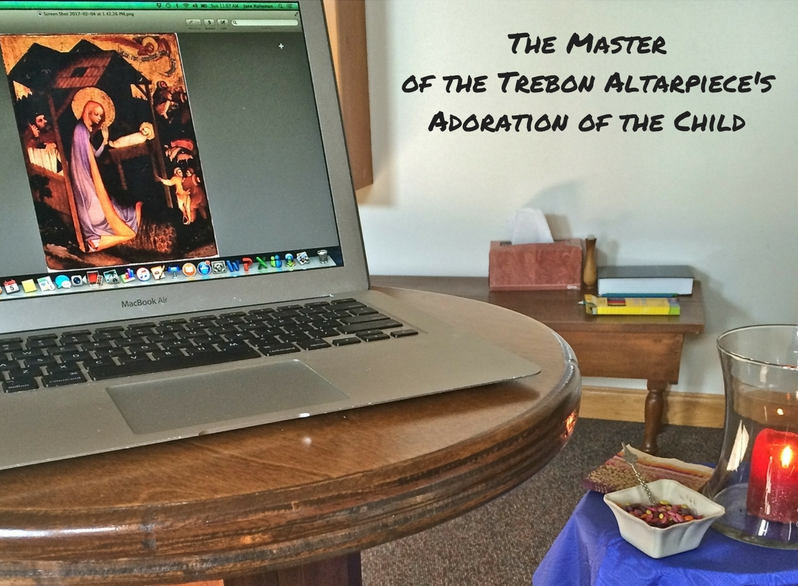
Visio Divina's second Sunday image
Add a comment
January 30, 2017
By: Jane Bishop Halteman
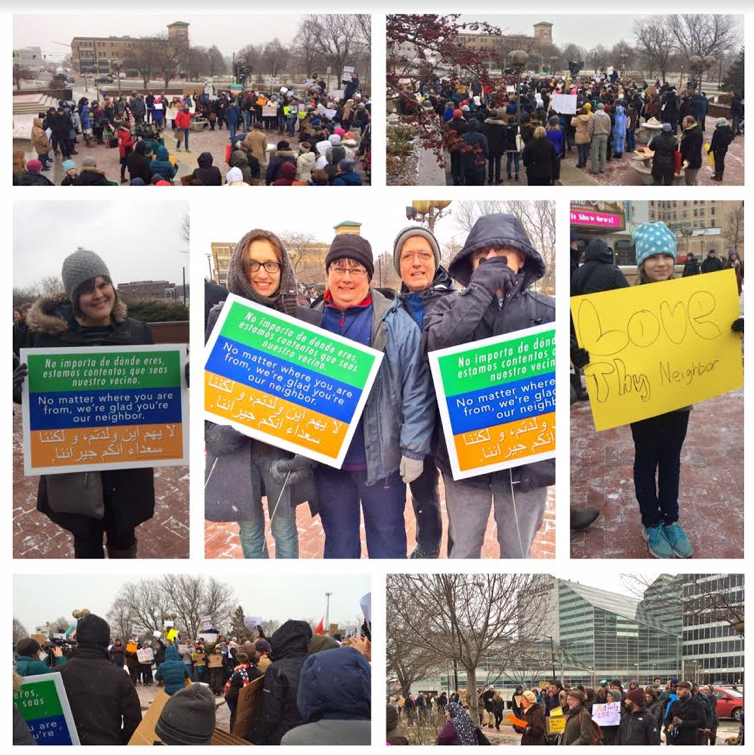
Kern Roaders participate in South Bend No Ban No Wall rally
It was cold and snowy, but that didn’t deter at least 11 KRMCers (and possibly more) from making time to participate in the last-minute “No Ban No Wall” rally Sunday afternoon in front of the Morris Performing Arts Center in downtown South Bend. With prompts to attend from Janna on the congregation’s Facebook page and our faithful daughter, we made it out the door on the heels of our return from a small group gathering. Armed with our "We're Glad You're Our Neighbors" sign, we trotted briskly around the Morris block, spotting family and friends and a diverse group of others speaking their collective mind about the “No Ban No Wall” agenda.
Only a week has passed since five KRMC women attended the Women's March on Washington, which was good preparation for local events yesterday and more to come, we presume, but so much already has changed in just a week since the presidential transition that it’s somewhat difficult to recall back to the euphoria we experienced immediately after the march.
Prior to the event, Janna reported that “I am going in order to facilitate a formational experience for my daughters. I want them to understand themselves as Anabaptist Christian women worthy of respect and capable of caring for others. Janna and Amara, eight, and Addie, six, picked up Janna’s mother in Ohio, and connected with her sister, aunts, and cousins in DC.
“As a part of our being there, we also were in active dialogue with other members of the family as to why we participated and how we engaged with the variety of positions represented at the march, which was an extraordinary demonstration of what it means to say no to hate in creative, celebratory, positive ways,” Janna noted.
Becky, who went with her two sisters, said she “came away from the weekend inspired to go beyond a mere involvement in a march to actually carry on the spirit of the march by taking whatever constructive action I can. Already today (Monday a week ago), I've called Sen. Todd Young's office to register my opposition to Betsy DeVos as secretary of education. Same call goes to Joe Donnelly tomorrow. On Wednesday, I'll be calling Rep. Jackie Walorski asking her to save Obamacare, or at any rate, not to end it before something similar is in place.
“I was exhilarated to see rest stops in Ohio filled with women, many wearing pussy hats,” Becky continued. “I wear my pussy hat proudly and call it by that name. I knitted seven of them, including ones worn by my daughter and two granddaughters who marched in St. Louis. We had the same experience coming back through Ohio. Women honked and waved at sight of our hats or perhaps were tipped off by the Obama/Biden sticker on my minivan,” Becky observed.
Danile explained that she is “pleased that the definition of the word 'pussy' has been successfully transformed by a sea of cat-eared, hand-knitted pink hats.” She said she thoroughly enjoyed the weekend and indicated that she “was excited by those who showed up to express their resistance to a leader who is seemingly incapable of introspection, self criticism, curiosity, and compassion. I enjoyed being with my traveling companions and hosts, and in the capital city for a weekend. I was lifted by the generosity of spirit of the (hundreds of) thousands at the march and the many we met on the way there and back. I loved the creativity of so many signs, their wit and incisiveness, and hope. I am energized to work against discrimination, exploitation, and greed. I plan to collaborate with the many local movements to prevent the erosion of good things accomplished in our country, state, and community.”
Brenda, too, shared that she “was energized by the solidarity of concern about this administration regardless of specific agenda and excited by the warm positive effect of so many passionate people; however, I was also met with backlash on social media and from a few coworkers about my decision to attend. I came away with hope that a large swath of people of all stripes with varying agendas have awakened from apathy to believe it is essential that we speak up. I truly feel motivated to more active political involvement in a way I have not before. That is my responsibility.”
Prone to anxiety about elevators, subways, and crowds, I could have succumbed to my fears and stayed away from the march; in fact, when pastor Janice reached out to Janna, Danile, Becky, Brenda, and me because she knew we were all traveling to DC, I answered: “Thanks for sharing with the congregation, Janice, and for the prayers of the people. I find myself a bit anxious about the travel, the crowds, the potential risks, bathroom options, etc., so will greatly appreciate you all remembering us…”
Much to my astonishment, the good vibes of the marchers and the prayers of the people made manageable the anxieties I had feared battling on this daunting excursion. My desire to witness the Washington gathering as a self-care mechanism, to fulfill a need to experience solidarity with folks who still care about the earth and all its inhabitants as we stand at the threshold of a strange new world that threatens not to take care of the least of these, apparently overtook the fear. I would like to be wrong about the changes I fear in Washington, but, in the meantime, I found it necessary to walk in solidarity with the marginalized on every front.
Most of the KRMC women who participated in the DC march reported dissonance with some of the signs and speaker sentiments expressed there, but, as Brenda said for all of us, “I do not feel responsible for the varying views and level of respect vs. anger expressed at the march; I believe participating was a positive, if imperfect, journey.”
After filing her post-march report, Brenda offered this inspirational addendum about attending a meeting with co-workers: “A member of the group started the meeting by asking me to share about my experiences in DC. I was totally unprepared to do that, recognizing that people were present who had radically different political views than I. What I ended up saying spontaneously was much more conciliatory, reaching across the divide, than I would have expected to come out of my mouth a week earlier. I explained why I embraced the pink pussy hats, though reluctantly at first, but also acknowledged why they could be seen as offensive. I shared my belief that many people were present, young people in particular, who had never been politically engaged before, and, regardless of which way they might choose to vote, they will now see the importance of being empowered.
“It felt really important to me, transformational, that this amazing experience not be seen as offensive or hateful to people who might view it differently,” Brenda concluded.
Becky's comment that “I hope there's room for the angry among us to sit at the table with those who advocate a quiet approach,” resonates with me. I, too, hope we can listen well to each other as a new political climate continues to unfold before us. I trust our congregation will find ways to resist authentically new government mandates that are not in keeping with our understanding of the Gospel.
Add a commentJanuary 23, 2017
By: Jane Bishop Halteman
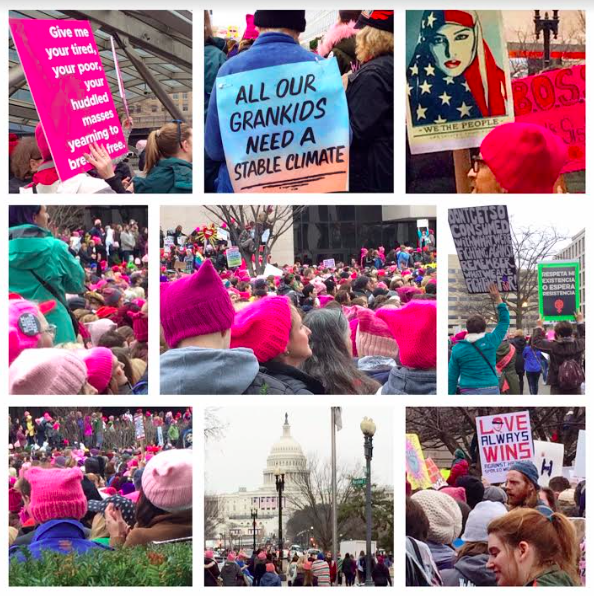
I was hopeful I would have stories to tell you about Mennonites singing at the Women’s March on Washington, but, truth be told, my sister-in-law and I, who traveled together by train from Philadelphia to DC Friday afternoon and arrived home Sunday evening, never saw another Mennonite as far as we know!
The Associated Press estimated a crowd of approximately 500,000 and “a Metro official said that more than a million rail trips were taken Saturday, the second-highest day in its history after Barack Obama’s first inauguration in 2009,” according to The New York Times, so it’s not surprising that we ran across no familiar faces, including the other women from Kern Road, whom I expect will log reports on their experiences for next week’s post.
The two of us will not soon forget the massive, jostling, but very orderly crowds, Saturday’s overcrowded Metro, our restroom run back to the hotel (because the mobs obscured any view of the temporary facilities), the fact that we could find no place but our hotel to eat after the march.
We will not soon forget the passion of speakers Gloria Steinem, Michael Moore, Ashley Judd, and many more. We will not soon forget the young family we met making signs in our hotel Friday night as they prepared to march with their disabled daughter on behalf of all those with disabilities. We will not soon forget those in wheelchairs and strollers, using knee rollers and walkers, pushing baby carriages and grocery carts.
We will not soon forget the silver-haired Japanese woman we talked to as we left Union Station Sunday afternoon. She told us that, at her age, she did not expect to be marching again for the rights of the marginalized, something she’s been doing since the 60s. The Japanese are not prone to confrontation, she told us, but they have marched for two causes over the years: this one and against nuclear war.
We will not soon forget the women, men, and children who gathered from all across the country, who spent time and money to assemble peacefully on behalf of “justice and equity for all.” They marched for many reasons as illustrated by the array of signs they carried: to stop white silence, to manage global warming, to unite against hate, to promise we will never go back, to announce love always wins, to declare themselves proud to be Muslims, to assert that our grandkids need a stable climate, to affirm that Black lives matter, to proclaim that our daughters are still watching, to acknowledge that we’re glad you’re our neighbor, to suggest we make diversity great again, to remind us that when others go low we go high.
We will not soon forget the compassionate marchers who assisted us as we climbed through a thick hedge when we needed to escape the masses, the immediate attention others gave the woman who dropped to the ground as we were passing, the accommodation offered those walking the opposite direction of the majority, the easy conversations we struck up with sister/brother participants in restaurants and on the Metro. For whatever reason any of us chose to participate, it seemed we felt a solidarity with this enormous throng of fellow Americans.
March co-founders Breanna Butler and Evvie Harmon called the response overwhelming, pointing out that the movement has become global as nearly 200 cities were signed on to participate in Saturday’s march. Here’s how the founders envisioned the march’s impact: “In the spirit of democracy and honoring the champions of human rights, dignity, and justice who have come before us, we join in diversity to show our presence in numbers too great to ignore. The Women’s March on Washington will send a bold message to our new administration on their first day in office, and to the world that women's rights are human rights. We stand together, recognizing that defending the most marginalized among us is defending all of us.
“We support the advocacy and resistance movements that reflect our multiple and intersecting identities. We call on all defenders of human rights to join us. This march is the first step towards unifying our communities, grounded in new relationships, to create change from the grassroots level up. We will not rest until women have parity and equity at all levels of leadership in society. We work peacefully while recognizing there is no true peace without justice and equity for all.”
As people of faith, how do we respond to these needs and concerns, Sojourners asks? “We respond the way Jesus did.” Check out this link for recommendations about not sitting out this one. The Mennonite published this opinion piece about why the author planned to participate in Saturday's event: “The Women’s March on Washington is a reclamation of voice. This unification of women is about creating solidarity: showing up and speaking up. We are marching because we have endured in silence for too long. We are marching because we cannot be complacent, instead, we must displace ourselves from comfort. We are marching because in the coming years, we must be the church: we must be present in suffering, we must be raw in our grief, and we must actively seek the upside-down kingdom,” says Hanna Heishman.
How will we at Kern Road “be present in suffering, raw in our grief, and actively seeking the upside-down kingdom?” Now is the time to begin to prepare for these undertakings. I look forward to sharing next week KRMC women’s responses to their march experiences.
For a more comprehensive picture of women’s marches here at home and around the world, see this series of photos.
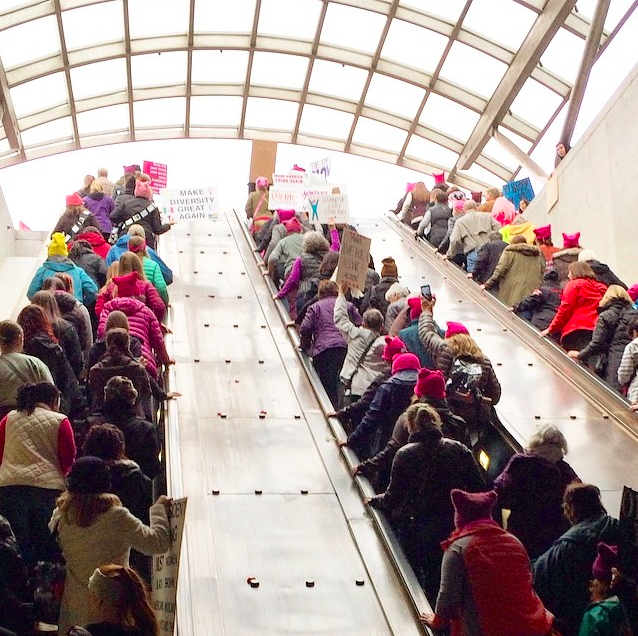
Onward and upward as the work continues (Metro escalator at L'Enfant Plaza, Washington DC)
Add a comment
